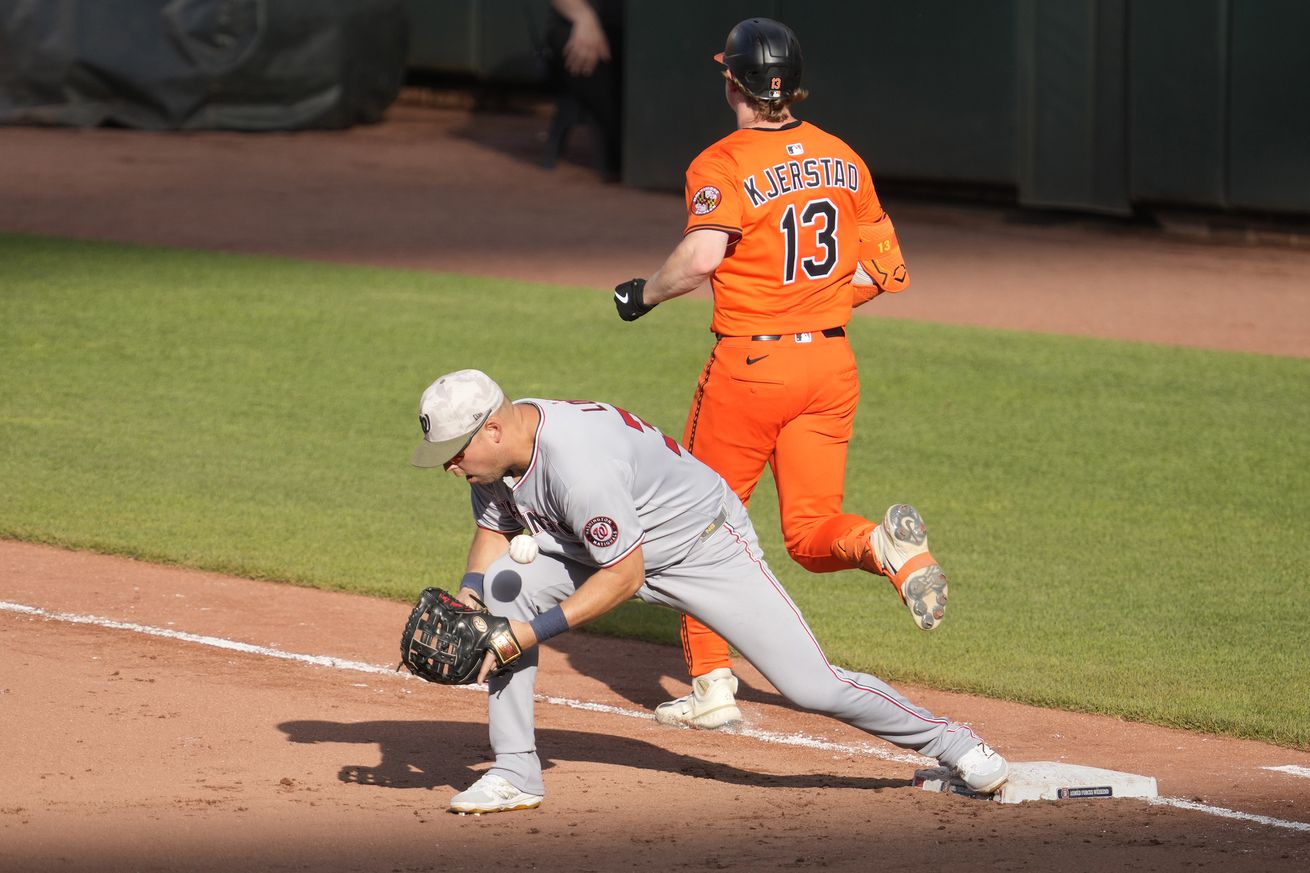
He’s finally healthy, but he’s still chasing pitches low in and out of the zone, and grounding into lots of outs.
It’s too soon to call the season a failure, but suffice it to say, a team doesn’t underperform as severely as the 2025 Orioles without several things going wrong at once. There are all-too-predictable failures—it turns out, failing to sign a top-flight starting pitcher does not pay dividends in terms of wins. But also unpredictable ones, like how all of the last few years’ top draft picks have stopped hitting at once. Adley has been mired in a slump seemingly since last summer. Gunnar started the year off hot, then cooled off (but he’s seemingly heating up again). Colton Cowser has stopped hitting at all, because he’s been out with a broken thumb.
Another perplexing downturn at the plate is that of the O’s’ big lefty bat from the University of Arkansas. This was supposed to be “the year of Heston Kjerstad,” but so far, the second-overall pick in the 2020 draft has gotten off to a lousy start at the plate. He’s hitting .203/.252/.331/.582 and one of the team’s least valuable players, at -0.8. Mark Brown has called him a routine deliverer of “Orioles tragic,” due to his RISP woes.
This is, of course, bad, because Kjerstad is supposed to be one of the crown jewels of the tankathon days in which, under a new Mike Elias regime, the team would routinely lose 100+ games in order to sew up a high draft pick. Kjerstad was one of those picks, a sweet-hitting outfielder with a 50 hit tool, 55 power, and a 55 arm. According to his MLB Pipeline scouting report, the Razorbacks outfielder brought a winning package of strength, bat speed and “a ton of hard contact,” with the ability to “drive the ball over the fence and for extra bases to all fields.” Despite that, Kjerstad was also thought to manage his strikeouts well.
As you know, his pro career has hit some major snags, most not his fault. “Silent J” was OPS’ing 1.304 at Arkansas in his Draft year when the pandemic cut short the season. He wasn’t able to play again until June 2022 because of a diagnosis of myocarditis, a viral inflammation of the heart. He earned a call-up to the Majors in September 2023 after winning Arizona Fall League MVP honors in fall 2022 and posting a .904 OPS in 2023 between Double-A and Triple-A. But he failed to get playing time, with Anthony Santander occupying right field, and then, just as it seemed he had found his footing in the Majors, with a red-hot .378/.465/.676 line in June ‘24, New York Yankees reliever Clay Holmes beaned him in the head, leaving him with a concussion that sidelined him for most of the rest of the season.
So, if not 2024, then surely 2025 would be the year, finally, of the Kjerstad coming-out party? Well, with Cowser sidelined, Kjerstad is finally getting lots of playing time, but a .203 average and 68 OPS+ is not what the Orioles had envisioned from their 2020 first-rounder.
Might a look at peripherals tell us more? Kjerstad’s barrels have gone way down since his debut 2023 season, from 20% to 9.5%. His average exit velocity has also dipped 3 mph, which makes him a below-average hitter. He is not striking out more than he did as a rookie (less, in fact), but he’s walking much less.
Early this season, Fangraphs took a look and concluded that this year, we’d “find out a lot” about Heston Kjerstad as a hitter. They praised Kjerstad’s ability to hit the ball hard—he still does, in the 68th percentile of all hitters—but raised two questions he’d have to answer to stick. One, could he stop hitting into so many double plays (e.g. when you hit a grounder to the pull side)? Two, could he stop chasing pitches out or at the fringes of the zone?
The answer to both, sadly, has been no. Kjerstad is tied for the team lead in GIDP with Adley Rutschman and Ryan Mountcastle in close to 50 fewer plate appearances. His chase rate, 36.3% is up from a career average of about 34.1% and well above the major league average of 28.9%. In 2024, Kjerstad posted a 12.4% walk rate and 28.9% strikeout rate in Triple-A; this season, his strikeouts have not gone up (27.6% K rate), but his walk rate is one-fourth what it was, at 3.1%.
Overall, this means he’s whiffing a lot, and when he’s making contact (especially on the ground) it’s not especially productive. Pitchers have adjusted by throwing Kjerstad a lot of offspeed stuff, against which he’s struggled this season, especially. He will need to learn to lay off pitches low in and below the zone, to which he’s extremely susceptible.
A guy drafted No. 2 overall in 2020 who ran an above-average 116 OPS+ over two brief early seasons, Kjerstad has dropped hints that his bat could play at the major league level before. But with a not-too-hot 68 OPS+ currently, there’s not enough good to outweigh the bad right now.
Just as last year, the Orioles are left with something of an incomplete picture of Heston Kjerstad. Until Colton Cowser returns to action, Kjerstad has a spot on the roster and a place in the lineup, but he’s not exactly making the most of it now. Is the lefty a platoon bat? A DH only? Trade bait, like Kyle Stowers, Connor Norby and Joey Ortiz? The next few months will be vital in filling in the picture. Like the rest of this team, you have to hope Heston Kjerstad figures his issues out, and soon.